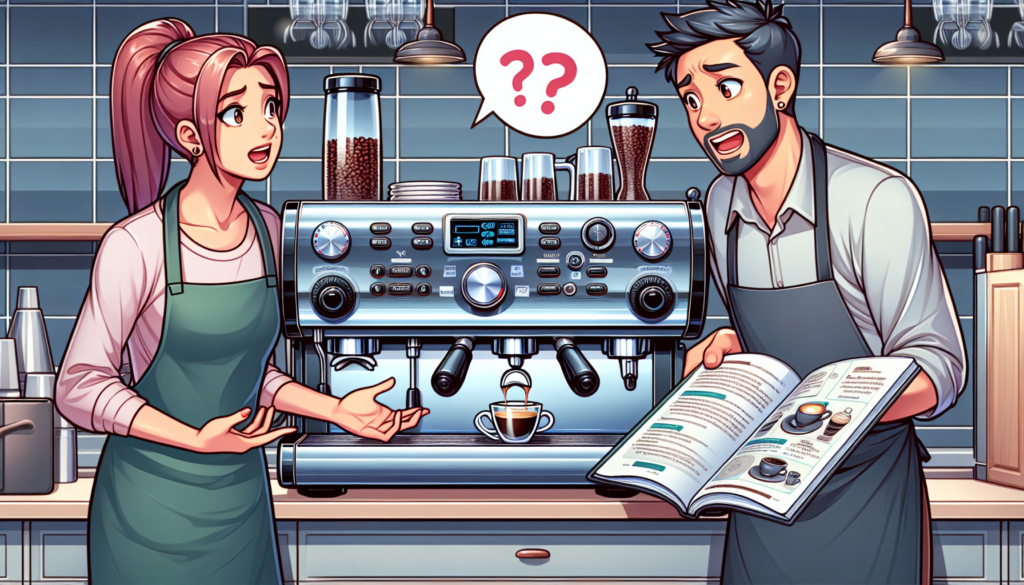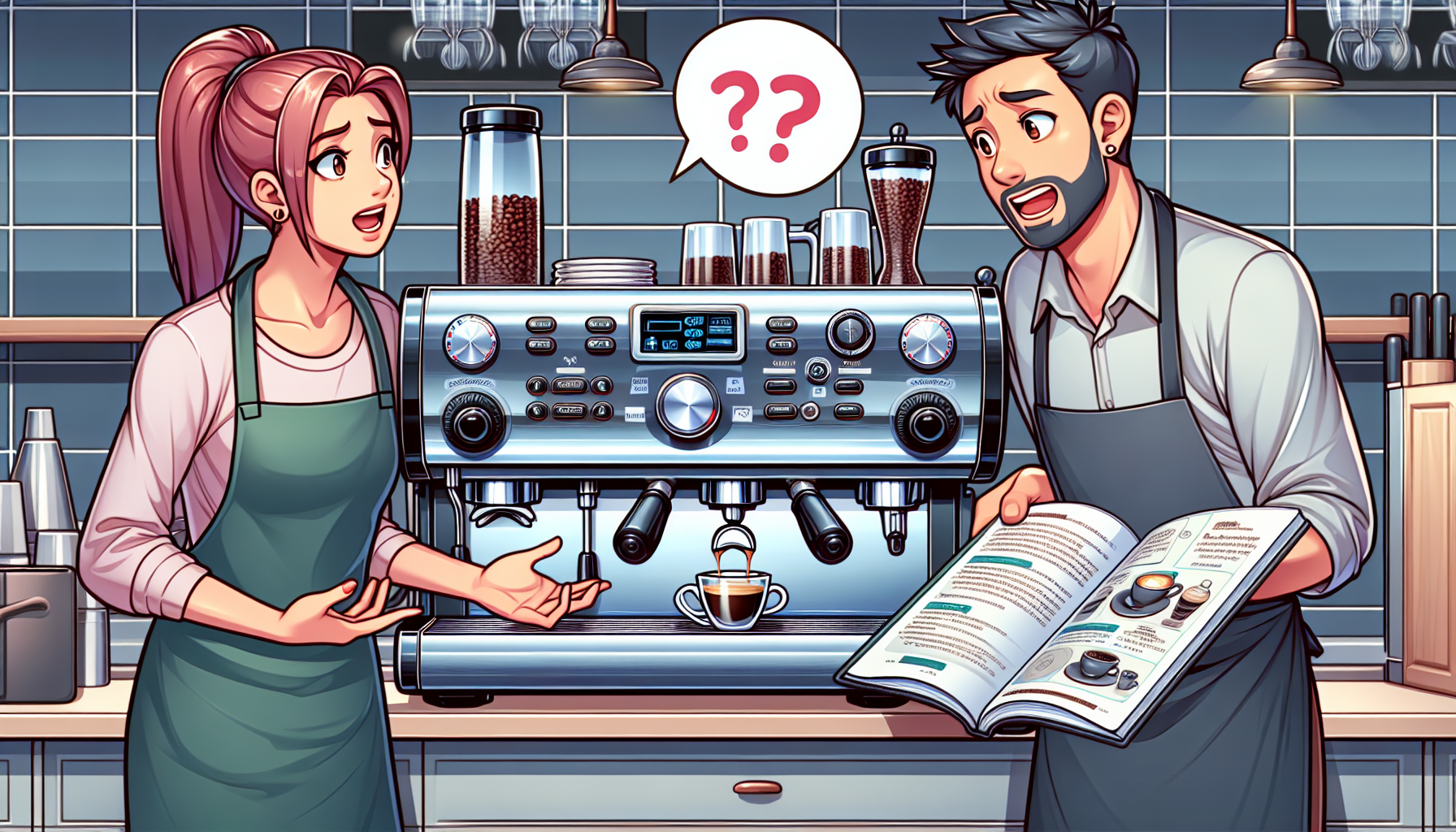Have you ever wondered if using an espresso machine is a difficult task? Fear not! In this article, we will explore the question: are espresso machines hard to use? Whether you are a coffee enthusiast looking to upgrade your brewing skills or a curious beginner exploring the world of espresso, we will provide you with an insight into the usability of espresso machines. So grab a cup of your favorite brew and let’s demystify the art of using an espresso machine together!

CHECK OUT ESPRESSO MACHINES ON AMAZON
Choosing an Espresso Machine
Budget Considerations
When choosing an espresso machine, it’s important to consider your budget. Espresso machines can range significantly in price, from affordable options for beginners to high-end models used by professionals. Determine how much you’re comfortable spending and look for machines within that price range. Remember that while more expensive machines may offer additional features and better build quality, there are plenty of affordable options that can still produce excellent espresso.
Machine Types
Espresso machines come in various types, each with its own pros and cons. The most common types include manual, semi-automatic, and fully automatic machines. Manual machines require more skill and effort to operate, as they require you to control the brewing process yourself. Semi-automatic machines offer some automation, such as controlling water temperature and brew pressure. Fully automatic machines, on the other hand, handle almost everything for you, from grinding the coffee beans to extracting the espresso. Consider your level of expertise and preference for involvement when deciding which type of machine to choose.
Ease of Use Features
When selecting an espresso machine, it’s worth considering the ease of use features it offers. Look for machines with programmable settings, intuitive controls, and clear displays. Some machines even have built-in tutorials or guidance systems to help you navigate through the brewing process. Additionally, consider the size and footprint of the machine, as well as the ease of cleaning and maintenance. Choosing a machine with user-friendly features will ensure that you have a smoother and more enjoyable experience with your espresso machine.
Preparing the Machine
Initial Setup
After purchasing an espresso machine, it’s important to properly set it up before use. Follow the manufacturer’s instructions to assemble any detachable components, such as the portafilter and water reservoir. Make sure that all parts are securely in place to prevent any leaks or malfunctions during the brewing process. It’s also a good idea to prime the machine by running water through it once before making your first espresso. This will help ensure that the machine is ready to go and that any residual manufacturing oils or debris are flushed out.
Water Reservoir
The water reservoir is a crucial component of an espresso machine as it provides the water necessary for brewing espresso. It’s important to fill the reservoir with clean, filtered water to achieve the best-tasting espresso. Check the machine’s user manual for the recommended water capacity and refill accordingly. Some machines also have water level indicators, which can be helpful in monitoring the remaining water. Regularly clean the reservoir to remove any buildup or impurities that may affect the taste of your espresso.
Grinder Settings
One of the key factors in brewing a delicious espresso is the fineness of the coffee grounds. Most espresso machines come with a built-in grinder or have a portafilter that accommodates pre-ground coffee. If your machine has a grinder, it’s essential to adjust the grind settings to achieve the desired extraction. Experiment with different settings to find the ideal fineness for your taste preferences. If you opt for pre-ground coffee, make sure to choose a grind size specifically labeled for espresso to ensure proper extraction.
Grinding and Tamping
Choosing the Right Coffee Beans
The quality and freshness of the coffee beans have a significant impact on the taste of your espresso. Invest in high-quality beans that have been roasted within the past two weeks for the best flavor. Look for beans that are specifically labeled for espresso, as they are typically roasted to bring out the rich and bold flavors desired in espresso. Consider exploring different coffee origins and blends to find the ones that suit your palate the best.
Grinding Consistency
Consistency in grinding the coffee beans is crucial for extracting a well-balanced espresso. Aim for a grind size that is fine but not too powdery. If the coffee is ground too coarse, the water will pass through too quickly, resulting in a weak and under-extracted espresso. On the other hand, if the coffee is ground too fine, the water will struggle to pass through, resulting in a bitter and over-extracted espresso. Experiment with grind settings to find the sweet spot that produces a rich and flavorful shot.
Tamping Pressure
Tamping is the process of compressing the coffee grounds evenly in the portafilter before brewing. It plays a vital role in creating resistance and allowing the water to extract the flavors from the coffee. Apply firm and even pressure when tamping the grounds to ensure a consistent and level surface. Avoid applying too much pressure, as it can cause channeling and uneven extraction. A quality tamper with a flat and leveled base is recommended for better control and consistency. Practice your tamping technique to achieve the desired results.
Brewing Espresso
Portafilter Usage
The portafilter is a handle-like device used to hold the coffee grounds and attach to the espresso machine. It is an essential component in brewing espresso. Ensure that the portafilter is clean and dry before each use to prevent any residue from affecting the taste of your espresso. Fill the portafilter evenly with finely ground coffee, distributing it evenly across the basket. Avoid overfilling the portafilter, as it can lead to uneven extraction and potential mess during the brewing process.
Dosing and Distribution
Achieving the correct dose of coffee is crucial for consistent espresso extraction. Experiment with different dosages to find the perfect amount for your taste preferences. Use a digital scale to measure the weight of the coffee for better accuracy. After filling the portafilter, distribute the coffee grounds evenly across the basket using a distribution tool or your finger. This helps to ensure an even extraction and avoid any dry or over-extracted spots in the coffee puck.
Shot Extraction
The extraction process is where water is forced through the coffee grounds in the portafilter, extracting the flavors and oils from the coffee to produce espresso. The ideal extraction time for a shot of espresso is typically between 20 to 30 seconds. If your shot extracts too quickly, it may result in a weak and sour-tasting espresso. Conversely, if it extracts too slowly, it may result in a bitter and over-extracted espresso. Adjust the grind size, dose, and tamping pressure to achieve the desired extraction time and taste.
Steaming Milk
Milk Frothing Techniques
Steaming milk is an art form that requires practice and technique. To achieve creamy and velvety textured milk for lattes and cappuccinos, start by choosing cold, fresh whole milk. Properly position the steam wand just below the milk’s surface, angling it slightly to create a whirlpool effect. Pay close attention to the temperature, aiming for around 150°F (65°C). Avoid overheating the milk, as it can result in a burnt taste. Experiment with different techniques and practice regularly to master the art of milk frothing.
Steam Wand Usage
The steam wand is a key component in steaming milk and requires proper handling. Before steaming, purge the steam wand to remove any condensed water or milk residue. Insert the wand into the milk pitcher and turn the steam knob to start the steam flow. Position the steam wand correctly, making sure it is submerged just below the milk’s surface. Keep the pitcher at a slight angle and gradually lower it as the milk expands and froths. Practice and precision are crucial in mastering the use of the steam wand.
Creating Microfoam
Microfoam is the silky-smooth and velvety milk texture used in latte art. To achieve microfoam, it’s important to create small, tightly packed bubbles in the milk during the steaming process. This is achieved by positioning the steam wand correctly and introducing the right amount of air into the milk. As the milk froths, monitor the swirl and texture until it reaches the desired consistency. With practice, you’ll learn how to achieve the perfect microfoam for latte art and enhance the overall presentation of your espresso drinks.
Cleaning and Maintenance
Daily Cleaning Routine
Proper cleaning and maintenance are essential for maintaining the longevity and performance of your espresso machine. Develop a daily cleaning routine that includes wiping down the exterior of the machine, cleaning the portafilter, and removing any leftover coffee grounds. It’s also important to regularly empty and rinse the drip tray and clean the steam wand, removing any milk residue. Check the machine’s user manual for specific cleaning instructions and recommended cleaning products to ensure proper maintenance.
Descaling
Over time, mineral deposits from water can accumulate in the internal components of the espresso machine, affecting its performance and taste. Descaling is the process of removing these deposits and should be done regularly to keep your machine in top shape. Follow the manufacturer’s guidelines for descaling, which typically involve using a descaling solution or a mixture of water and vinegar to flush out the mineral buildup. Ensure thorough rinsing after descaling to remove any residues that may impact the flavor of your espresso.
Grouphead Maintenance
The grouphead is the part of the espresso machine where the portafilter attaches and where the water is sent to extract the espresso. Regular maintenance of the grouphead is essential to keep it clean and free from any debris. After each use, wipe down the grouphead with a clean cloth to remove any coffee grounds or residues. It’s also recommended to use a cleaning brush to clean the shower screen and the gasket to prevent any clogs or leaks. Take care not to damage any components and follow the manufacturer’s instructions for grouphead maintenance.
Common Challenges and Troubleshooting
Shot Timing
Timing the shot is crucial in achieving a well-extracted espresso with balanced flavors. If your shots are extracting too quickly, resulting in under-extracted espresso, you can try adjusting the grind to a finer setting, increasing the dose, or applying more tamping pressure. On the other hand, if your shots are extracting too slowly and taste over-extracted, try grinding coarser, reducing the dose, or adjusting the tamping pressure. It may take several adjustments and trial-and-error to find the perfect timing for your espresso.
Bitter or Sour Taste
The taste of your espresso can offer insights into potential issues with your brewing process. If your espresso tastes bitter, it may be over-extracted, meaning it has been brewed for too long or with too fine of a grind. To remedy this, shorten the extraction time, coarsen the grind, or reduce the dose. On the other hand, if your espresso tastes sour, it may be under-extracted, indicating that it has been brewed for too short of a time or with too coarse of a grind. Adjusting the extraction time, grinding finer, or increasing the dose can help balance the flavors.
Milk Steaming Issues
Steaming milk can be challenging, especially for beginners. If you’re having issues achieving the desired texture and temperature, consider the following troubleshooting tips. If your milk is not frothing properly, make sure the steam wand is fully submerged and that there is adequate air intake. If the milk is overheating or scorching, focus on positioning the steam wand correctly and monitoring the temperature closely. It’s also important to use fresh and cold milk for better results. Regular practice and experimentation will help you overcome these challenges and achieve excellent milk steaming results.
Experimenting with Different Recipes
Classic Espresso
Once you have mastered the basics of brewing espresso, it’s time to explore different recipes and variations. Start with perfecting the classic espresso shot, which serves as the foundation for a variety of espresso-based drinks. Experiment with different coffee bean origins, grind settings, and extraction times to find the perfect balance of flavors. Pay attention to the aroma, body, and taste profiles to discover the nuances that different beans and brewing techniques can bring to your espresso.
Cappuccino
Cappuccino is a classic espresso-based drink loved for its creamy texture and balanced flavors. To make a cappuccino, start by brewing a shot of espresso. Froth milk to create a rich and velvety microfoam. Pour the desired amount of milk into the espresso shot, aiming for equal parts espresso, steamed milk, and milk foam. Experiment with different milk ratios and milk frothing techniques to find the perfect balance between espresso and milk in your cappuccino.
Latte Art
For those looking to add a creative touch to their espresso drinks, latte art is a skill worth exploring. Latte art involves pouring steamed milk into espresso in a way that creates intricate patterns or designs on the surface. Mastering latte art requires patience, practice, and an understanding of milk steaming techniques. Start with simple designs like hearts or rosettas and gradually progress to more complex designs as you gain confidence and improve your pouring skills. Remember, practicing latte art is not only visually appealing but also enhances the overall drinking experience.
CHECK OUT ESPRESSO MACHINES ON AMAZON
Tips for Beginners
Start with a Simpler Machine
If you’re new to making espresso at home, it’s advisable to start with a simpler machine. Manual or semi-automatic machines are great options for beginners as they offer more control and allow you to learn the fundamentals of brewing espresso. These machines also tend to be more affordable, making them a practical choice for those who are just starting their espresso brewing journey. As you gain experience and refine your skills, you can always upgrade to a more advanced machine that offers additional features and automation.
Practice Consistently
Consistency is key when it comes to brewing espresso. Make it a habit to practice regularly and establish a routine that works for you. Practice your dosing, grinding, tamping, and shot extraction techniques consistently to develop muscle memory and refine your skills. Keep in mind that making excellent espresso takes time and effort, so be patient with yourself and embrace the learning process. With dedication and practice, you’ll gradually improve your barista skills and be able to consistently brew great-tasting espresso.
Seek Guidance from Professionals
If you’re serious about becoming a skilled home barista, don’t hesitate to seek guidance from professionals. Attend coffee workshops, join online forums or communities dedicated to espresso brewing, and connect with experienced baristas who can offer valuable insights and tips. Learning from those who have mastered the art of espresso making can significantly enhance your skills and understanding of the process. Don’t be afraid to ask questions and actively engage with the coffee community to expand your knowledge and elevate your espresso brewing skills.
Conclusion
Choosing an espresso machine and venturing into the world of brewing your own espresso can be a rewarding experience. With the right machine, knowledge, and practice, you can develop your barista skills and enjoy the journey of creating delicious espresso drinks. Embrace the learning process and don’t be discouraged by challenges along the way. With time and dedication, you’ll be able to consistently produce high-quality espresso, experiment with different recipes, and even master the art of latte art. So, go ahead, choose your espresso machine, and start your caffeinated adventure!

